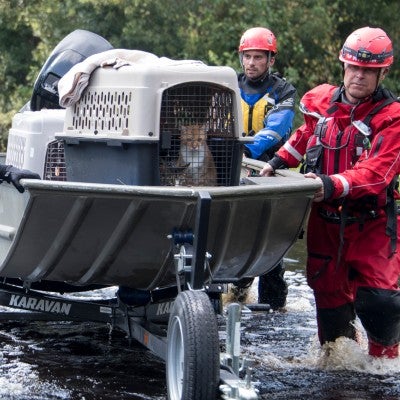You're driving your car when you see a dog on the side of the road. With a sinking feeling, you realize they are alone. What should you do?
This is a wrenching scenario for all who care about animals. After all, what if your own pet were standing there? Use our guidelines for providing safe and effective help.
Don't cause an accident
You can't help an animal if you become injured in the process. Look in your rear-view mirror before braking, turn on your signal, pull your car completely off the road, turn off the ignition, set the parking brake, and put on the hazard lights. If you have emergency flares, prepare to use them.
Catch them safely
Safety first
A strange, frightened, and possibly sick or injured animal can behave unpredictably. A sudden move on your part, even opening your car door, can spook them and cause them to bolt—possibly right onto the highway. If the animal looks or acts threatening, or if you feel uneasy about the situation, stay in your car.
If possible, restrain the animal. Create a barrier or use a carrier, leash, piece of cloth, or length of rope to keep the animal in the area. Signal approaching vehicles to slow down if you cannot confine the animal, or divert traffic around them if they appear to be injured and is still on the roadway.
Use caution
Use caution when approaching the animal. Should you succeed in getting close enough to capture them, you stand a good chance of being scratched or bitten.
When moving toward the animal, speak calmly to reassure them. Make sure they can see you at all times as you approach, and perhaps entice them to come to you by offering strong-smelling food such as canned tuna or dried liver.
Lure them into your car
If you are certain you can get help from animal control very soon, try to lure the animal into your car with food, close the door and wait for help. In most cases it isn't a good idea to attempt to drive somewhere with a strange dog unrestrained in your car; they may become frantic or aggressive. Cats may do the same, as well as lodge themselves under the car seat, and it can be dangerous trying to extract them.
Call for backup
If you're not able to safely restrain the animal, call the local animal control agency (in rural areas, call the police). Do so whether or not the animal is injured, and whether or not they are wearing an identification tag. Leave your phone number with the dispatcher, and try to get an estimate of how long it may take someone to respond. If possible, stay on the scene to keep an eye on the dog or cat until help arrives. Make sure you report to authorities precisely where the animal is by using road names, mile markers or landmarks.
Sign up to receive our exclusive e-book full of important information about caring for your pet, including training techniques and answers to frequently asked questions.

Transport to safety
If you are able to transport the animal, take them to the nearest animal shelter. If you plan to keep the animal in the event no owner is found, notify animal control that you have the animal or that you have taken them to a veterinary hospital for treatment. You can usually place a free "found" ad in your local newspaper or on sites like Craigslist. Keep any identification, such as collar or tags.
If you decide to take the animal home
If you decide to try to find the owner yourself, be sure to contact your local animal shelter or animal control office first. This will give you an opportunity to let the appropriate agency know that you have the animal and to provide a description to them, in case the owner contacts them. Also, have the animal scanned for a microchip; this quick ID check could help you find the owner right away.
Before bringing the animal home, make sure you can keep your resident animals separate; the found animal could be sick, fearful or aggressive with other animals. Once you have them safely at your home, take pictures and create a “found pet” flier to post around the area in which the animal was found. You can also post notices at veterinary hospitals and on websites such as petfinder.com.
If you’ve tried to find the owner without success, but are unable to keep the animal long-term, you can try to re-home the animal yourself.
Be prepared
If you know in your heart that you're a rescuer, why not equip yourself to do the best possible job? Here are some things to have in your car at all times:
- Phone; phone numbers of local animal control, a shelter, and a 24-hour emergency veterinary clinic
- Cat carrier or cardboard box
- Collars and strong leashes for dogs
- Heavy blanket; water bowls and water
- Strong-smelling foods, such as canned tuna or dried liver
- An animal first-aid kit.
Check the laws
To check on any relevant laws in your state, county, or town and contact your local animal control agency, humane society or SPCA Many times the animal you find along the highway will turn out to be un-owned, unwanted, and unclaimed. Even so, the person finding the stray dog or cat does not automatically become the owner or keeper until they ha satisfied certain state and/or local requirements.
In almost every state, the animal is not "owned" by the finder until the holding period for strays (as specified by state or local laws) has expired and the finder has made an attempt to reunite the animal with their original owner and/or has taken steps—obtaining vaccinations, license, collar and identification tag—to prove they are now the owner.
Shelters and agencies
Understand the limitations of shelters and animal care and control agencies. For instance, you can take a badly injured stray dog to animal control and find out that the agency is unable to provide expensive surgery to treat the dog's injuries. In those cases, shelters may euthanize the animals to relieve their suffering. Virtually all animal control facilities have severe budgetary or space limitations and must make painful decisions about how best to allocate their inadequate resources.
Visiting a veterinarian
Before you take an injured animal to a private veterinary hospital for treatment, be willing to assume financial responsibility for the animal. Good care is not cheap, and many veterinarians have many Samaritans in their waiting rooms every year. Anyone who is committed to trying to save injured stray animals should discuss these issues in advance with the veterinarian.
Things to consider
If you're uncertain about whether or not to help or keep an animal you see alongside the road, here's a final word of advice: First, think of what you would want the finder of your animal to do if they happened to find them injured without their collar.
You'd want them to take your pet to a veterinarian, and you'd want them to try to find you. At the same time, be reasonable about how much you can afford to do for that animal if no owner shows up.
Good Samaritans who have never lost a cherished companion animal may conclude that the owner of the found dog or cat callously abandoned them or, at the very least, neglected to keep them safely confined at home. But accidents can happen to anyone. The frantic owner could be looking everywhere for their beloved pet.
Finally, be honest with yourself in answering these questions: Are you willing to add them to your household? And will you be willing to return them to their original home if the owner turns up after you've started to form an attachment? If you answer “no” to these questions, your best option may be to take the animal directly to the shelter or contact animal control for assistance.

